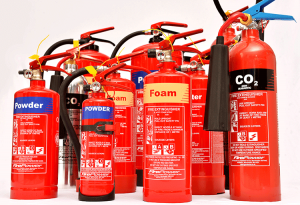Everything You Need to Know About Fire Extinguishers: Types, Ratings, Maintenance and More. Leave a comment

Fire safety is a crucial concern in any setting, whether it’s a home, office, commercial or industrial facility. One of the most important tools for fire safety is the fire extinguisher. In this article, we’ll provide an overview of the different types of fire extinguishers, their ratings, and how to properly maintain and inspect them.
Types of Fire Extinguishers There are different types of fire extinguishers available for different types of fires. It’s important to choose the right type of fire extinguisher based on the type of fire that might occur. Here are some common types of fire extinguishers and their uses:
- Class A Fire Extinguishers: These are suitable for fires that involve ordinary combustibles, such as wood, paper, and cloth.
- Class B Fire Extinguishers: These are used for fires involving flammable liquids, such as gasoline, oil, and grease.
- Class C Fire Extinguishers: These are designed for fires involving electrical equipment, such as computers, appliances, and power tools.
- Class D Fire Extinguishers: These are used for fires involving combustible metals, such as magnesium, titanium, and sodium.
- Class K Fire Extinguishers: These are used for fires involving cooking oils and fats, commonly found in commercial kitchens.
- ABC Fire Extinguishers: These are multipurpose extinguishers that can be used for Class A, B, and C fires.
- CO2 Fire Extinguishers: These are ideal for electrical fires because they don’t leave any residue.
- Water Fire Extinguishers: These are effective for Class A fires but should not be used on electrical fires.
- Foam Fire Extinguishers: These are suitable for Class A and B fires and leave a sticky residue.
- Dry Chemical Fire Extinguishers: These are effective for Class A, B, and C fires but leave a powdery residue.
- Carbon Dioxide Fire Extinguishers: These are best for small fires in confined spaces and are not suitable for Class A fires.
Fire Extinguisher Ratings In addition to the different types of fire extinguishers, there are also different ratings based on the size of the fire they can extinguish. Fire extinguishers are rated based on the following classes:
- Class A: Suitable for ordinary combustibles, such as wood, paper, and cloth.
- Class B: Suitable for flammable liquids, such as gasoline, oil, and grease.
- Class C: Suitable for electrical fires.
- Class D: Suitable for combustible metals.
- Class K: Suitable for cooking oils and fats.
The ratings are represented by a number and letter, such as 1-A, 10-B:C, or 40-K. The higher the number, the more effective the extinguisher is at putting out a fire.
Fire Extinguisher Maintenance and Inspection Proper maintenance and inspection of fire extinguishers are crucial for their effectiveness in case of a fire. Here are some tips for maintaining and inspecting your fire extinguishers:
- Check the pressure gauge regularly to ensure that the extinguisher is fully charged.
- Make sure the pull pin is intact and the tamper seal is not broken.
- Check for any signs of damage or corrosion, such as dents, cracks, or leaks.
- Inspect the hose or nozzle for any obstructions or damage.
- Schedule regular servicing and inspection of your fire extinguishers with a qualified professional.
- Refill or recharge your fire extinguisher after use or when the pressure gauge indicates



